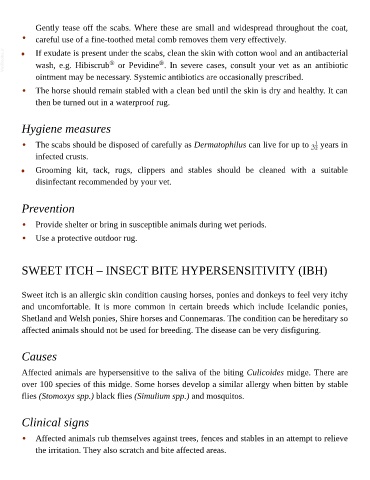Page 832 - The Veterinary Care of the Horse
P. 832
Gently tease off the scabs. Where these are small and widespread throughout the coat,
• careful use of a fine-toothed metal comb removes them very effectively.
VetBooks.ir • If exudate is present under the scabs, clean the skin with cotton wool and an antibacterial
®
®
wash, e.g. Hibiscrub or Pevidine . In severe cases, consult your vet as an antibiotic
ointment may be necessary. Systemic antibiotics are occasionally prescribed.
• The horse should remain stabled with a clean bed until the skin is dry and healthy. It can
then be turned out in a waterproof rug.
Hygiene measures
• The scabs should be disposed of carefully as Dermatophilus can live for up to years in
infected crusts.
• Grooming kit, tack, rugs, clippers and stables should be cleaned with a suitable
disinfectant recommended by your vet.
Prevention
• Provide shelter or bring in susceptible animals during wet periods.
• Use a protective outdoor rug.
SWEET ITCH – INSECT BITE HYPERSENSITIVITY (IBH)
Sweet itch is an allergic skin condition causing horses, ponies and donkeys to feel very itchy
and uncomfortable. It is more common in certain breeds which include Icelandic ponies,
Shetland and Welsh ponies, Shire horses and Connemaras. The condition can be hereditary so
affected animals should not be used for breeding. The disease can be very disfiguring.
Causes
Affected animals are hypersensitive to the saliva of the biting Culicoides midge. There are
over 100 species of this midge. Some horses develop a similar allergy when bitten by stable
flies (Stomoxys spp.) black flies (Simulium spp.) and mosquitos.
Clinical signs
• Affected animals rub themselves against trees, fences and stables in an attempt to relieve
the irritation. They also scratch and bite affected areas.

